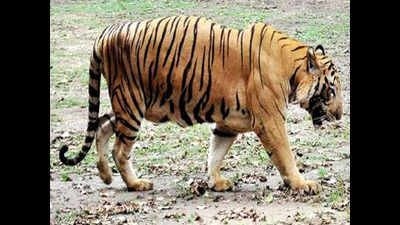- News
- City News
- lucknow News
- Uttar Pradesh forests new pit stop for migrant tigers
Trending
This story is from December 25, 2018
Uttar Pradesh forests new pit stop for migrant tigers

The tigers have been clicked in Sohagibarwa wildlife sanctuary in Maharajganj district that is linked to tiger reserves in Bihar and Nepal. (Representational photo)
LUCKNOW: There could at least be four 'migrant' tigers in UP at present. They could have either come from Bihar or Nepal.
The tigers have been clicked in Sohagibarwa wildlife sanctuary in Maharajganj district that is linked to tiger reserves in Bihar and Nepal.
Tiger census 2018 for the first time is counting tigers in three sanctuaries, Sohagibarwa in Maharajganj, Suhelwa in Balrampur and Shravasti and Ranipur in Chitrakoot, outside the tiger reserves.
Migrant tigers are the ones that cross over from other states. While Suhelwa and Sohagibarwa constitute fragmented tiger population in the east, Ranipur marks presence of tigers in Bundelkhand region. Initial results of the census show presence of four tigers in Sohagibarwa. "One of them is a tigress. In Suhelwa we have seen none so far," said chief conservator of forests, Ramkumar. The three sanctuaries are connected to tiger-dominant areas in neighbouring states and Nepal through wildlife corridors.
Ranipur is about 150 km away from Panna tiger reserve along UP-MP border.
Though there is no count available for tigers in these areas yet, pugmarks and sightings of big cats have been recorded.
"The last census showed no tigers in Suhelwa, but this time villagers and staff have seen tigers in the area. In winters, tigers migrate from Nepal," said an official from Suhelwa wildlife division.
In Ranipur, state government has already proposed developing a tiger reserve given the frequent crossing-over from Panna.
The data of the ongoing tiger census, which is in its fourth and last phase, shows that these sanctuaries also have resident tigers along with migrant population.
The tigers have been clicked in Sohagibarwa wildlife sanctuary in Maharajganj district that is linked to tiger reserves in Bihar and Nepal.
Tiger census 2018 for the first time is counting tigers in three sanctuaries, Sohagibarwa in Maharajganj, Suhelwa in Balrampur and Shravasti and Ranipur in Chitrakoot, outside the tiger reserves.
Migrant tigers are the ones that cross over from other states. While Suhelwa and Sohagibarwa constitute fragmented tiger population in the east, Ranipur marks presence of tigers in Bundelkhand region. Initial results of the census show presence of four tigers in Sohagibarwa. "One of them is a tigress. In Suhelwa we have seen none so far," said chief conservator of forests, Ramkumar. The three sanctuaries are connected to tiger-dominant areas in neighbouring states and Nepal through wildlife corridors.
Sohagibarwa is connected to Valmiki tiger reserve in Bihar and Royal Chitwan national park in Nepal. Suhelwa has linkages with Banke national park in Nepal and also has 120 km of contiguous Indo-Nepal border stretch.
Ranipur is about 150 km away from Panna tiger reserve along UP-MP border.
Though there is no count available for tigers in these areas yet, pugmarks and sightings of big cats have been recorded.
"The last census showed no tigers in Suhelwa, but this time villagers and staff have seen tigers in the area. In winters, tigers migrate from Nepal," said an official from Suhelwa wildlife division.
In Ranipur, state government has already proposed developing a tiger reserve given the frequent crossing-over from Panna.
The data of the ongoing tiger census, which is in its fourth and last phase, shows that these sanctuaries also have resident tigers along with migrant population.
End of Article
FOLLOW US ON SOCIAL MEDIA










